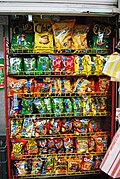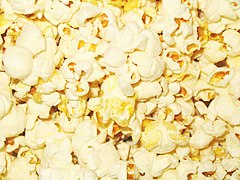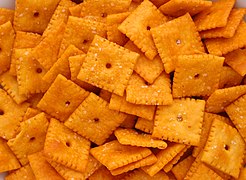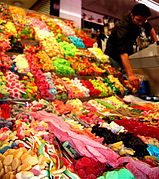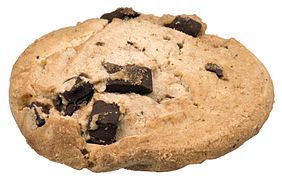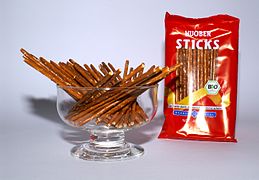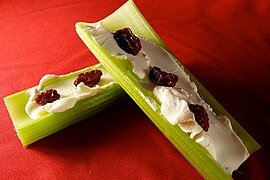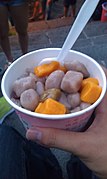|
Snack
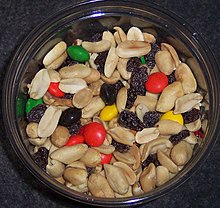
A snack is a small portion of food generally eaten between meals.[1] A snack is often less than 200[2] calories, but this can vary. Snacks come in a variety of forms including packaged snack foods and other processed foods, as well as items made from fresh ingredients at home. Traditionally, snacks are prepared from a number of ingredients commonly available at home without a great deal of preparation. Often cold cuts, fruits, leftovers, nuts, sandwiches, and sweets are used as snacks. With the spread of convenience stores, packaged snack foods became a significantly profitable business. Snack foods are typically designed to be portable, quick, and satisfying. Processed snack foods, as one form of convenience food, are designed to be less perishable, more durable, and more portable than prepared foods. They often contain substantial amounts of sweeteners, preservatives, and appealing ingredients such as chocolate, peanuts, and specially designed flavors (such as flavored potato chips). Aside from the use of additives, the viability of packaging so that food quality can be preserved without degradation is also important for commercialization.[3] A snack eaten shortly before going to bed or during the night may be called a "bedtime snack", "late night snack", or "midnight snack". AsiaIndiaIndian snack foods are typically called chaats. Snacks like pani puri and samosas have become popular outside of India. Most traditional snacks are home-made or sold by street vendors. Haldiram's is one of the top-selling and famous Indian snack brands around the world. IndonesiaKue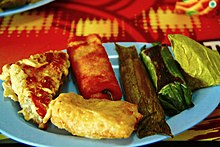 Indonesia has a rich collection of snacks called kue (cakes and pastry), both savoury and sweet. Traditional kue is usually made from rice flour, coconut milk, and coconut sugar, and is mostly steamed or fried rather than baked. Traditional kue are popularly known as kue basah ("wet kue") that has a moist, soft texture because of rich coconut milk. Kue kering (dried kue) is the local name for cookies. Indonesia has several variations of kue, both native and foreign-influenced.[citation needed] Traditional crackers Traditional crackers are called krupuk, made from bits of shrimp, fish, vegetables or nuts, which are usually consumed as a crunchy snack or an accompaniment to meals.[4] These crispy snacks are sometimes added to main dishes for their crunchy texture; several Indonesian dishes such as gado-gado, karedok, ketoprak, lontong sayur, nasi uduk, asinan and bubur ayam are known to require specific types of krupuk as toppings. There are wide variations of krupuk available across Indonesia. The most popular ones would be krupuk udang (prawn crackers) and krupuk kampung or krupuk putih (cassava crackers). Other popular types include krupuk kulit (dried buffalo-skin crackers), emping melinjo (gnetum gnemon crackers), and kripik (chips/crisps), such as kripik pisang (banana chips) and keripik singkong (Cassava chips). Rempeyek is a flour-based cracker with brittle of peanuts, anchovies or shrimp bound by a crispy flour cracker. Rengginang or intip (Javanese) is a rice cracker made from sun-dried and deep fried leftover rice. JapanJapan has a very wide range of snack foods, some of which are internationally popular, ranging from onigiri to melon pan. Malaysia
Taiwan
Thailand
North AmericaCanadaIn 2010, the average Canadian ate 300 snacks.[6] Canadian identity is often associated with snack foods that are sold in Canada[7] due to economic nationalism.[8] Some Canadian snacks include ketchup chips, Smarties, Coffee Crisp, Kinder Surprise, Jos Louis, Big Turk, and Nanaimo bars.[9] United StatesIn the United States, a popular snack food is the peanut. Peanuts first arrived from South America via slave ships and became incorporated into African-inspired cooking on southern plantations. After the Civil War, the taste for peanuts spread north, where they were incorporated into the culture of such popular events as baseball games and vaudeville theaters.[10] Along with popcorn (also of South American origin), snacks bore the stigma of being sold by unhygienic street vendors. The middle-class etiquette of the Victorian era (1837–1901) categorized any food that did not require proper usage of utensils as lower-class.[10] Pretzels were introduced to North America by the Dutch, via New Amsterdam in the 17th century. In the 1860s, the snack was still associated with immigrants, unhygienic street vendors, and saloons. Due to loss of business during the Prohibition era (1920–1933), pretzels underwent rebranding to make them more appealing to the public. As packaging revolutionized snack foods, allowing sellers to reduce contamination risk, while making it easy to advertise brands with a logo, pretzels boomed in popularity, bringing many other types of snack foods with it. By the 1950s, snacking had become an all-American pastime, becoming an internationally recognized emblem of middle American life.[10][11] Middle EastNuts are a staple of snacks in the Middle East. Among the many varieties available within the region, the most popular are almonds, walnuts, hazelnuts, pine nuts, and pistachios.[12] According to archeological evidence, nuts have been part of the Middle Eastern diet for centuries with ancient civilizations taking advantage of them for their health benefits.[13] The health benefits of nuts comes from them being good sources of protein, healthy fats, fibers, vitamins and minerals.[14] Nuts have now become a regular snack with a 119 billion dollar market as of 2022 that is projected to continue growing into 2023.[15] Nuts can be prepared in a variety of ways, such as by roasting them with spices and lemon juice or incorporating them into food and desserts such as baklava, knafeh, and kibbeh.[16][17][18] 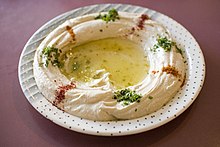 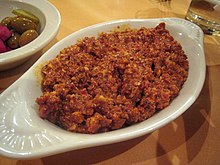 Spreads and dips are eaten with pita bread. The most popular dip in the middle east is hummus.[19] Hummus is a blend of chickpeas, tahini, lemon, and garlic usually served with olive oil and paprika on top.[20] Hummus's origins can be traced back to a Syrian cookbook from the 13th century.[21] Other dips are also popularly served such as mouhammara and baba ganoush.[19] Mouhammara is a walnut, tahini, and roasted red pepper dip served with olive oil on top originating from the Syrian city of Aleppo.[22] Baba ganoush is a spread made from roasted eggplants, olive oil, and other vegetables.[23] The origins of baba ganoush are not clear with many conflicting pieces of evidence pointing to multiple countries of origin.[24] A sweet dip is Ashta, a cream made from milk, rose or orange blossom water, and ghee, which is usually accompanied with honey.[25]  Many popular snacks in the Middle East are obtained from street vendors due to low cost and convenience of eating on the go.[26] Many of these snacks consist of a protein with bread.[26] Falafel consists of many little fried balls of ground chickpeas or fava beans with herbs, spices served in pita bread with tahini sauce and a choice of vegetables.[27] Falafel is believed to originate from Egypt around 1000 years ago by Egyptian Copts.[28] Shawarma is served in a similar fashion to falafel, pita bread with sauce and vegetables, but instead prepared by slowly cooking layers of meat on a spit before thinly slicing it.[29] 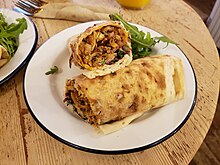 Nutrition
Government bodies, such as Health Canada, recommend that people make a conscious effort to eat more healthy, natural snacks, such as fruit, vegetables, nuts, and cereal grains while avoiding high-calorie, low-nutrient junk food.[30] A 2010 study showed that children in the United States snacked on average six times per day, approximately twice as often as American children in the 1970s.[31] This represents consumption of roughly 570 calories more per day than U.S. children consumed in the 1970s.[32] Types
Image gallery
See alsoReferences
Sources
Wikimedia Commons has media related to Snack food. Wikibooks Cookbook has a recipe/module on
|


